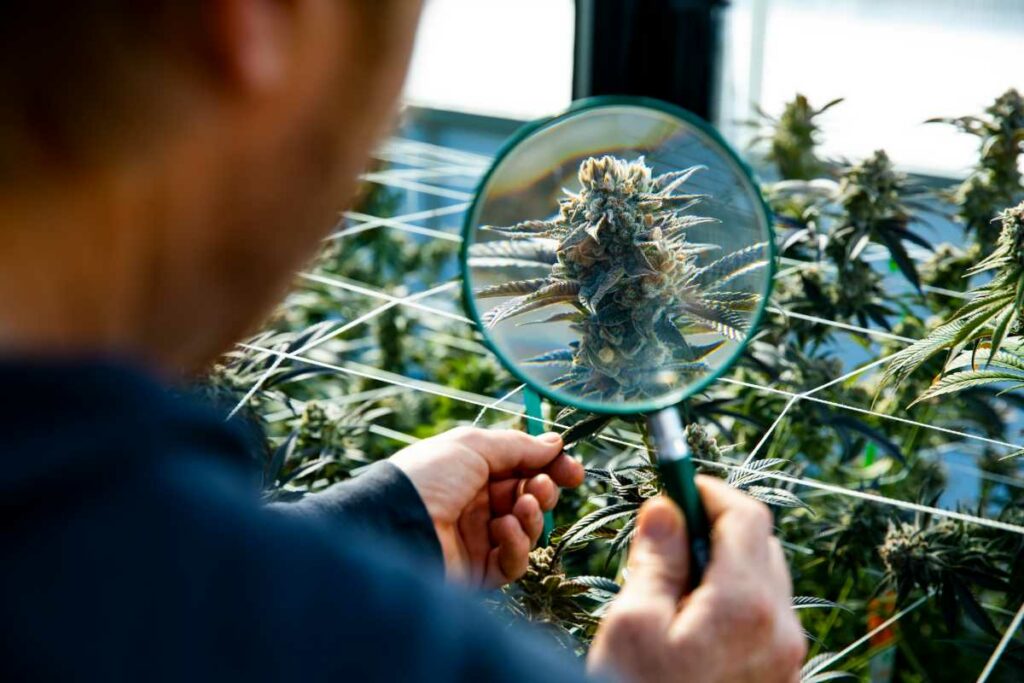Harvesting buds without killing the plant is a clever way to extend the plant’s life so that you get the maximum yield from it.
Cannabis is an annual plant, which means it should live from seed to fruit and then senesce in one year. That’s its natural lifecycle—seedling, vegging, flowering, harvest, and, lastly, senescence. It thus begs the equation of how growers can alter this natural growth cycle to add more life to their ladies.
How Do You Harvest Buds Without Killing The Plant?
It is possible to harvest buds without killing the plant. Just cut all the buds and leave everything else on the plant. Then change the lights to 24/0. This will revert the plant to the vegetation phase, and it will regrow more buds for a second harvest.
After the plant has successfully transitioned to the vegging stage, change the light to 18/6. This balances the light and dark hours for better vegetation growth.
Re-vegging cannabis plants for a second harvest means the plant will need to grow new bud sites. Thus, even though the plant is fully grown, it will take some time to regrow these bud sites.
With re-vegging, the grower focuses on stopping the plant’s journey towards senescence and re-igniting new growth.
Re-vegging is one of the miracles that indoor growers can bank on to get the most out of their plants before allowing them to die.
It works like a charm. It makes your cannabis plants function like mango trees, you know, allowing you to pick fruits as the plant continues to grow.
The problem with re-vegging is that it goes against the nature of the cannabis plant.
Cannabis plants aren’t adept at multi-tasking, so forcing them to grow branches and buds simultaneously is a bit of a stretch. The plant would rather grow leaves/branches or buds— not both at the same time!
So when you force the plant to give you two harvests in one lifetime, it suffers a lot of stress.
The plant will respond to the stress, and you will see the leaves growing with all manner of deformities. The edges of the leaves will become round instead of serrated.

The leaves will also lose their fingers. Instead of the 5-finger cannabis leaves we’re used to, the plant will have the 3-finger leaves, and on some, just a single leaf with rounded edges.
To harvest twice from the same plant is more like monster cropping, only that it doesn’t involve clones. The plant still suffers from having its parts cut, but you don’t grow new plants from the cuttings.
Instead, you depend on the already-harvested plant to grow new buds.
Monster cropping involves cutting clones from an already flowering plant and growing them as new plants. It is a high-stress training technique that should better be left to experienced growers.
It is more common than harvesting twice from the same plant because it gives just as much yield as ordinary clones, but faster.
Once you have harvested the plant once, you can re-veg it. It will grow new bud sites and grow new buds, but the harvest is always lower than the initial harvest.
Helpful Tips To Harvest Buds Without Killing The Plant
Harvesting a plant twice takes skill and precision. You have to know what to remove and what to retain so that the plant’s growth doesn’t stagnate.
Doing it right increases your chances of success and reduces the stress on the plant. These helpful tips will help you harvest buds without hurting the plant.
- Remove all the buds— Begin by harvesting the buds. Remove all buds, the ripe ones, and popcorn buds that you might not have use for.
While other growers leave the popcorn buds, they will eventually fall off, and so it makes no sense to leave them on the plant.
Removing the unripe buds also fosters a faster transition into the vegetation phase.
The assumption that leaving the unripe buds quickens your next harvest is wrong. The plant will have to grow anew— creating resultant buds afresh!
2. Remove some big old branches— Re-vegged plants grow bigger than ordinary plants. This is because their root system is more advanced, and the branches need to extend further to create new bud sites.
Removing the old branches gives you control over the plant’s height. You don’t want the plant to fill the tent or the top colas too close to the lights.
Cutting some old branches is essential when you’re growing indoors.
Outdoor growers can skip this part because space isn’t an issue for them, and there are no hanging lights to limit the plant’s vertical growth.
3. Leave the leaves and growth points— While cutting some of the old branches, keep the leaves and growth points. The leaves are important for photosynthesis, while the growth points spur new growth.
4. Change the nutrients— Changing the light hours is important, but you need to go back to the nutrients appropriate for vegging.
You need new growth and so feed them more nitrogen, less phosphorous, and moderate potassium. Changing to NPK 9-4-5 mix fosters new growth. You’ll revert to flowering ratios once the veg phase is over.
The Pros Of Harvesting A Cannabis Plant Twice
Harvesting a cannabis plant twice wouldn’t be practiced if it was all work and no profit. Here are some of the pros of harvesting without killing the plant:
- You don’t begin from zero— Harvesting the plant and re-vegging it for a second-time harvest saves you from beginning from zero. Unlike growing from seeds or clones, the plant has done most of the growing.
- Adds Stealth to Your Grow— One of the problems of stealth growing is having to dispose of the plants.
There are cases where growers were arrested because they dumped the old plants in the wrong place.
Re-vegging for a second harvest saves you from the stress of disposing of the plant and adds stealth to your weed-growing game.
- Re-vegging can save the vegetation time— Since the plant already has a robust root system, the new growth picks up faster.
Also, because you don’t start from seeds and clones, all the plant has to do is heal from the cuts and re-ignite new growth. This can shorten the vegging time.
The Cons Of Harvesting A Cannabis Plant Twice
Most growers do not harvest their plants twice. They’ll let the plant experience its natural growth, harvest, and senesce. Here are reasons why harvesting twice isn’t for everyone:
- You can’t train re-vegged plants well— When you re-veg a plant for a second harvest, you’re working with the old plant’s skeleton, which is rigid.
Thus, the rigid old skeleton won’t allow you to manipulate the plant as you would like for better yield.
Only seeds and clones afford you the pleasure of training the plant for better light penetration and improved yield.
- Lower yields— Re-vegged plants have left their best years in their first grow cycle. The harvest after re-veg is always lower than the first.
- The transition takes time— After harvesting, the plant will take some time before transitioning into the vegetation period fully.
- The plant can grow too big— If you’re growing indoors, you need to keep the plant’s height in check. Though some strains are suited for limited spaces, but re-vegged plants outgrow indoor spaces most times.
And we do this by training the plant. The problem with re-vegged plants is that they tend to grow too bushy, and their skeletons aren’t soft enough for easy training.
Frequently Asked Questions
Can Autoflowers Be Reverted To Vegetative Stage?
Autoflowers aren’t like photoperiod strains. They do not need the change in lighting schedules to begin flowering. Thus, autos aren’t sensitive to the 24/0 schedule that ignite re-vegging in photoperiods.
Autos are therefore not suitable for harvesting twice. Treat them as one-and-done plants.
Can I Harvest The Top Half Of My Plant?
You can harvest the top half of the plant and let the lower buds finish. The top buds are always more exposed to the light, and by nature, form first. You can remove them earlier so that they don’t lose their THC content.
You can harvest the buds at different times to avoid the degradation of THC and harvesting unripe lower buds.
In conclusion, you can harvest the buds without killing the plant. The plant can then be re-vegged by changing the light schedule to 24/0 and feeding them vegetation-appropriate nutrients. Still harvesting twice is a weed-growing trick that should be left to advanced growers.
REFERENCES:

